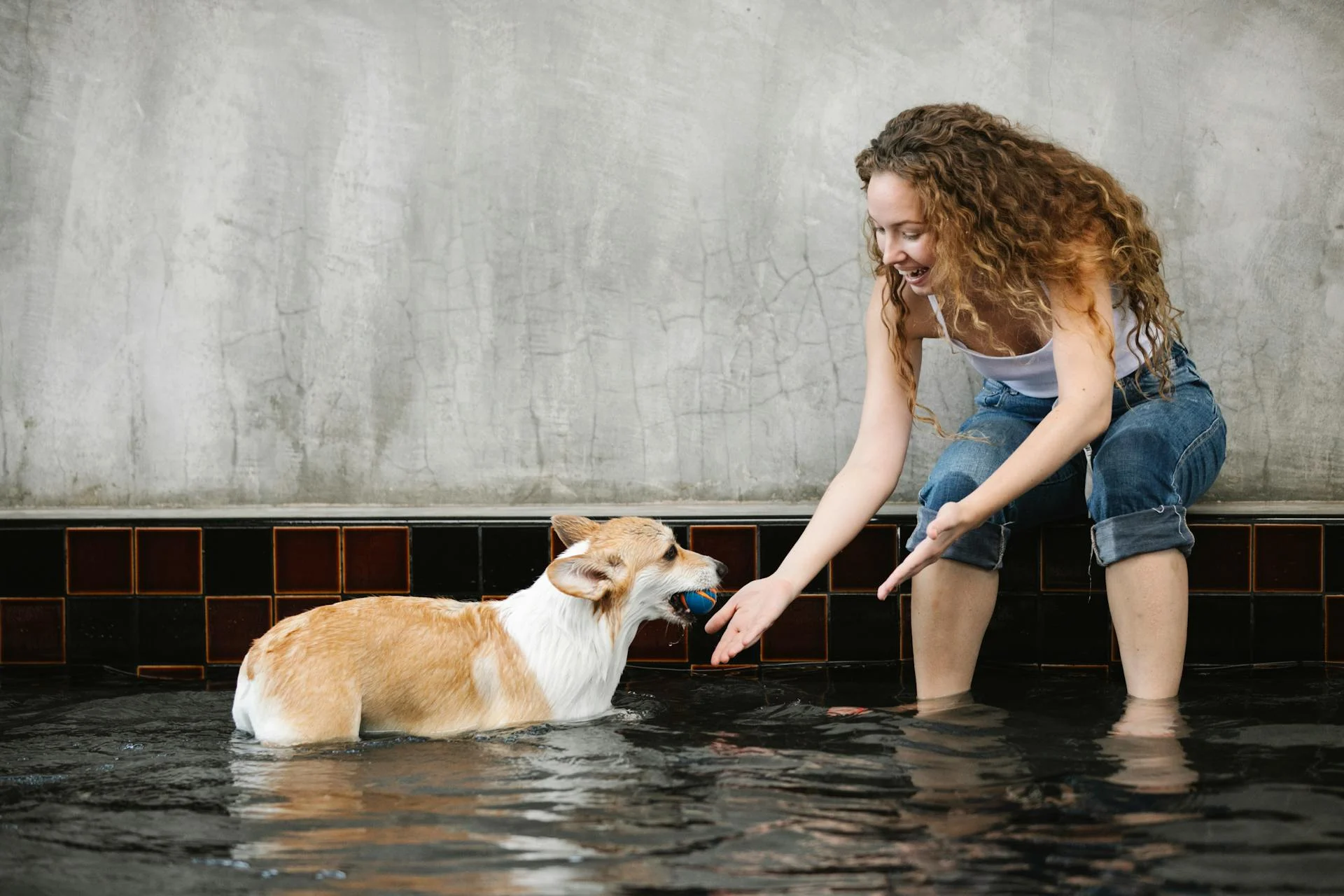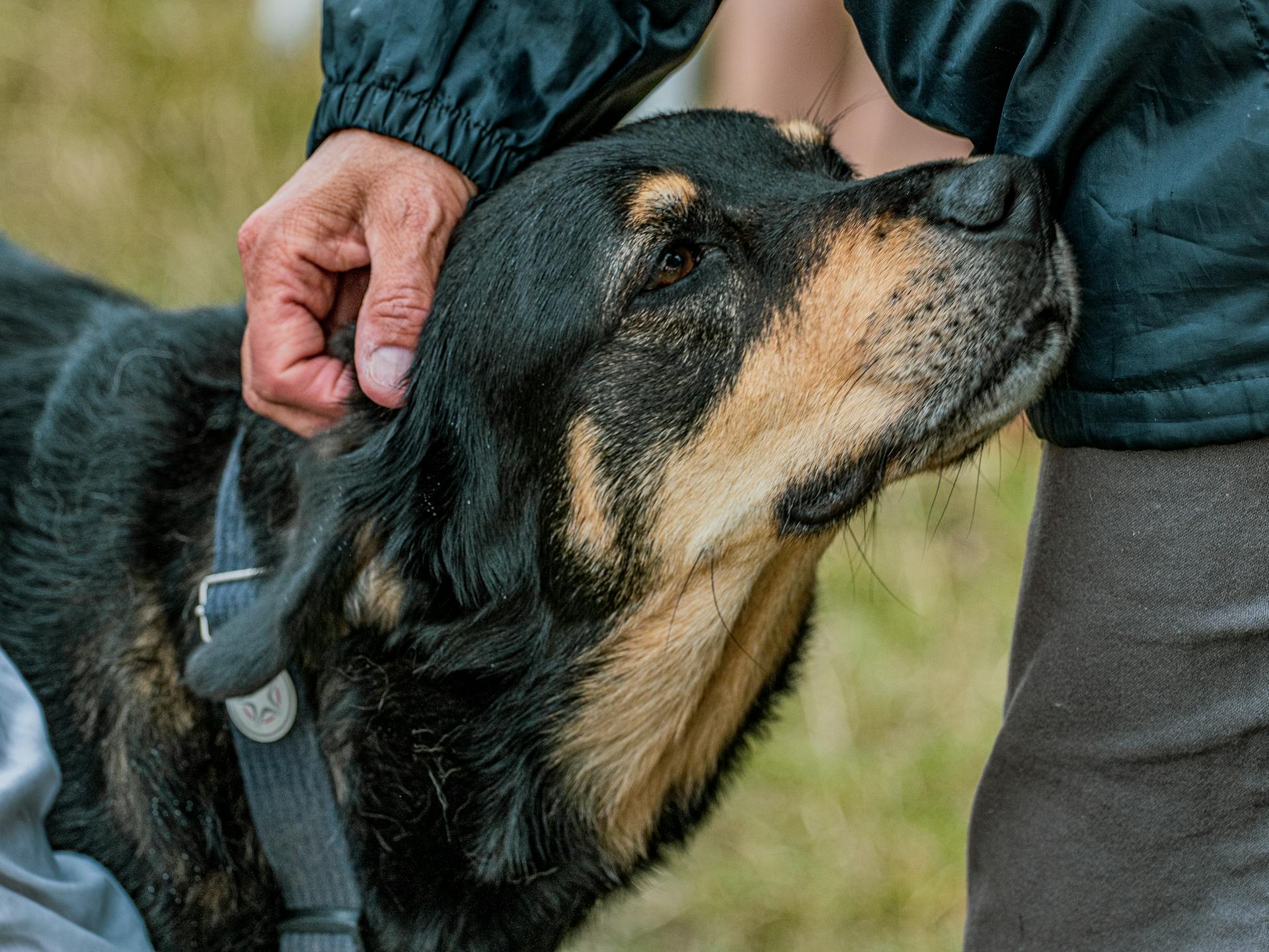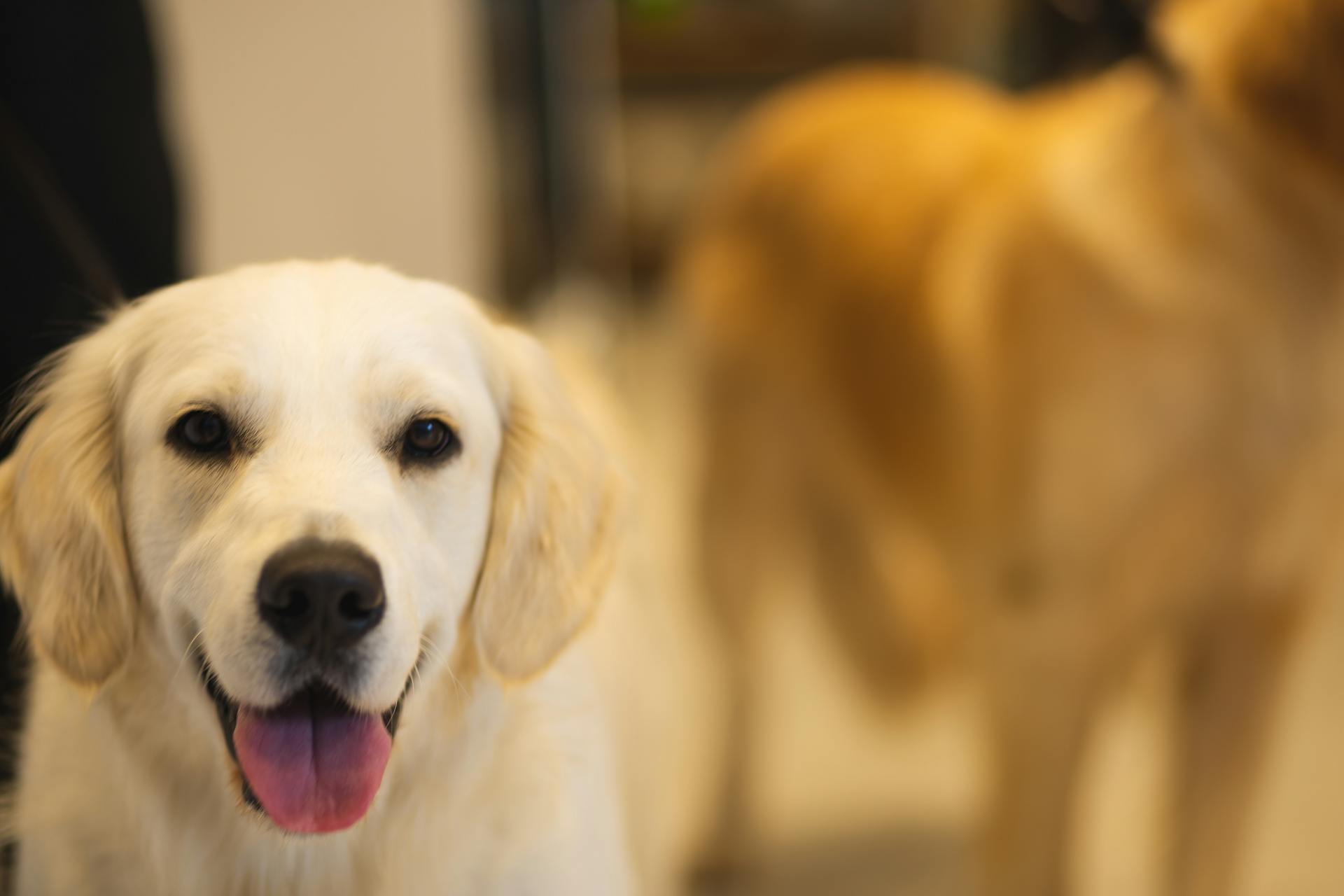
Calming signals are a fascinating topic that can help us understand how dogs and humans communicate and calm each other down. In fact, dogs use calming signals to diffuse tension and reduce stress in themselves and others.
A key example of a calming signal in dogs is the "calming touch", which involves gentle, soft contact with another dog or a human. This can be as simple as a light nuzzle or a soft paw touch. By using calming touch, dogs can signal that they're feeling relaxed and friendly.
Dogs also use other calming signals, such as yawning, licking their lips, and avoiding eye contact, to signal that they're feeling anxious or stressed. These signals can be subtle, but they're an important way for dogs to communicate their emotions.
By recognizing and understanding these calming signals, we can learn to respond in a way that helps our dogs feel more calm and relaxed.
Discover more: Hand Signal for down Dog
Calming Signals in Interactions
Calming signals are essential for dogs to function in their social groups, whether with other dogs or humans. They prevent situations from escalating and group members getting seriously hurt.
In dog-to-dog interactions, calming signals are used to diffuse aggressive behaviors and regain a peaceful social environment. Dogs have evolved peacemaking social mechanisms to alleviate, prevent, or resolve conflicts. Some of these behavior mechanisms are calming signals.
Some common calming signals include looking away, turning away, yawning, making a "soft face", freezing, lip licking, sniffing the ground, sitting, lying down, raising one paw, scratching, shaking off, play bow, blinking, slow movements, slow tail wagging with the tail held low, and moving in a curve.
Here are some calming signals that dogs use in social interactions:
By recognizing and responding to these calming signals, we can create a safer and more harmonious environment for both dogs and humans.
Dog-Human Interactions
Domestic dogs display interspecific signaling, specifically towards humans, with a great level of interaction between the two. This is because humans are their principle social partners.
Dogs use calming signals, such as licking their lips and looking away, to appease their human companions. These signals are used in both conspecific and heterospecific interactions.
In dog-human interactions, children under the age of six are least likely to correctly interpret auditory and visual calming signals displayed by dogs. This can lead to a greater probability of becoming victims of a dog attack.
Here are some common calming signals displayed by dogs in dog-human interactions:
- Turning the head aside, looking away
- Yawning during the sensation of an unnatural touch
- Licking the nose during an unwelcome embrace
- Licking the nose wearing an Elizabethan collar
It's essential to understand canine calming signals to experience positive interactions with dogs. By recognizing these signals, we can create a peaceful environment for both humans and dogs to coexist.
Broaden your view: Akc Printable Dog Training Hand Signals Chart Pdf
Conspecific Interactions
Dogs use calming signals to diffuse aggressive behaviors and regain a peaceful social environment after conflicts. These signals can be displayed by both opponents of the conflict or by a third-party member of the social group.
Familiarity and distance between two individuals affects the frequency of use of calming signals and the types of calming signals used. Dogs are more likely to use calming signals when there is a great enough probability that the direction of the encounter can be changed to de-escalate aggression.
Consider reading: How to Use a Flirt Pole
Calming signals can be voluntary, such as licking the lips, or involuntary, such as the release of odors from glands during high-stress interactions. In both cases, the recipient receives the signal, understands its meaning, and acts on this information, often taking action to mitigate the stressful environment by changing their body language or demeanor.
Here are some common calming signals used by dogs:
- Softening eyes
- Ears back
- Reducing body size
- Lifting a paw
- Sitting
- Freezing
- Showing side
- Licking nose
Dogs are skilled at recognizing and reacting to calming signals in their interactions. Even very young puppies show calming signals around older dogs to let them know that they mean no harm and to keep interactions safe.
Recommended read: Training Dog with Hand Signals
Understanding Calming Signals
Calming signals are a crucial aspect of canine communication. They help dogs convey their intentions and emotions to other dogs and even humans.
Dogs use calming signals to prevent situations from escalating and to show that they mean no harm. These signals can be observed in various contexts, such as social interactions between dogs or between dogs and their owners.
A unique perspective: Akc Dog Training Hand Signals
Turid Rugaas, a Norwegian dog trainer, introduced the concept of calming signals in her book "On Talking Terms With Dogs: Calming Signals." She identified around 30 forms of behavior or body language that dogs use to communicate with each other.
Some common calming signals include looking away, turning away, yawning, making a "soft face", freezing, lip licking, sniffing the ground, sitting, lying down, raising one paw, scratching, shaking off, play bow, blinking, slow movements, slow tail wagging with the tail held low, moving in a curve, and lip-smacking.
Here are some examples of calming signals in different contexts:
Dogs are skilled at recognizing and reacting to calming signals, even from a young age. Puppies will often use calming signals to interact with older dogs and show that they mean no harm.
By recognizing and responding to calming signals, we can create a more harmonious and peaceful environment for our dogs. We can also use calming signals to help our dogs feel more comfortable and secure in various situations.
Related reading: What Treats to Use for Dog Training
Research on Calming Signals
Turid Rugaas, a Norwegian dog trainer, introduced the concept of calming signals in her book "On Talking Terms With Dogs: Calming Signals". She describes around 30 forms of behavior or body language that dogs use in social interactions with other dogs.
The use of calming signals tends to lower the probability that another dog will act aggressively toward the dog doing the signaling. This is a crucial aspect of dog behavior and social interactions.
Some common calming signals include looking away, turning away, yawning, making a "soft face", freezing, and lip licking. These signals can be used by dogs to show that they mean no harm and to prevent situations from escalating.
Dogs are very skilled at recognizing and reacting to these signals in their interactions. Even very young puppies show calming signals around older dogs.
A list of the most common calming signals includes:
- Looking away
- Turning away
- Yawning
- Making a "soft face"
- Freezing
- Lip licking
- Sniffing the ground
- Sitting
- Lying down
- Raising one paw
- Scratching
- Shake off
- Play bow
- Blinking
- Slow movements
- Slow tail wagging with the tail held low
- Moving in a curve
- Lip-smacking
While Rugaas is not a scientist, her observations were insightful and the examples she gave were very convincing.
Recognizing Calming Signals
Dogs are very polite and often spend a long time showing calming signals before escalating a situation.
Recognizing calming signals is key to helping your dog avoid confrontations. Being able to identify these signals means you can help your dog not escalate interactions.
Dogs will often display calming signals in various situations, including interactions with you, other dogs, and people. They may also show calming signals in training situations.
If you find your dog displaying calming signals, help him out by moving him to a place where he can be more comfortable. Many dogs will do that themselves if they can, but often it is not possible due to physical restraints.
Dogs don't want to "get mad". Every confrontation is a danger to them as much as their opponent.
Additional reading: Does Getting a Female Dog Fixed Calm Her down
Contextual
Calming signals are not always easy to decipher, and context plays a huge role in understanding what they mean. A stressed yawn, for instance, looks a bit different from a normal yawn - it's more exaggerated, with the dog opening their mouth wider and curling their tongue.
Lip licking can be a calming signal too, especially when it's quick and not related to food or smell. I've seen dogs lip lick when they're feeling anxious in a training situation, and it's a subtle but important sign to recognize.
Spontaneous sniffing can be a sign of stress or discomfort, often in situations where the dog is expected to perform or focus. I've noticed this in dog sport trials, where a stressed dog might become engrossed in sniffing the ground instead of paying attention to their handler.
Walking your dog past barking dogs can also trigger sudden sniffing behavior, as the dog tries to deescalate the situation. It's essential to recognize these calming signals and respond accordingly, rather than escalating the situation with swift movements or loud noises.
Common Issues and Solutions
Calming signals can be tricky to recognize, especially if you're new to dog behavior. One common issue is misinterpreting a dog's body language, such as thinking a relaxed dog is anxious.
If a dog is feeling anxious or scared, they may display a "frozen" behavior, where they stop moving and remain still, as mentioned in the article. This can be a sign that they're trying to calm themselves down.
Some common calming signals that dogs use to calm themselves or others include licking, yawning, and avoiding eye contact. These signals can be subtle, so it's essential to pay attention to your dog's behavior.
Doubts and Questions
It's natural to have doubts and questions about calming signals in dogs. Confirmation bias can lead us to remember only the times when aggression de-escalated after a calming signal and forget the times when it didn't.
Some people believe that calming signals are a form of communication, but it's also possible that they're simply instinctive signs of stress. Yawning, for example, is known to be a sign of stress in dogs.
We should be concerned about confirmation bias because it can lead us to misinterpret the role of calming signals. A psychologist might suggest that calming signals are appeasement gestures meant to prevent hostile behaviors, but they could also be displacement behaviors caused by psychological conflict.
It's essential to consider the possibility that calming signals are not chosen by the dog as a means of communication, but rather an automatic response to stress.
You might enjoy: How to Stop Dog Biting Lead
Sudden Disobedience
Sudden Disobedience can be really frustrating, especially if you've worked hard to teach your dog new behaviors.
It's not uncommon for dogs to suddenly refuse listening to their owners, even if they've been trained well.
This can happen in situations like taking your dog to the city center for the first time, where he may feel overwhelmed by new sights and sounds.
Your dog is not forgetting what he's learned, he's just under too much stress to perform as well as he can.
In fact, even the best-trained obedience champions can forget their cues in stressful situations, like at the vet's office.
It's not about your dog's level of training or knowledge, but about his body's stress response taking over.
Being aware of your dog's calming signals can help you identify these moments and react accordingly, allowing your dog to calm down and perform better.
Expand your knowledge: Dogs and Tail Wagging
Reviews and Analysis
Turid Rugaas, a renowned Norwegian dog trainer, has spent over 30 years studying canine social behavior.
Her work has been praised by experts, including Patricia B. McConnell, Ph.D., who calls her insights "invaluable" and notes that her book can help deepen relationships with dogs.
The book, On Talking Terms with Dogs, is a must-have for dog lovers, with a revised edition offering new photos and examples that make understanding canine behavior easy and relatable.
Turid Rugaas has also written My Dog Pulls, What Do I Do?, and has lectured on canine social behavior worldwide.
You can learn calming signals by watching a video featuring Turid Rugaas, which shows footage of calming signals in action and how to use them to calm your dog.
The video is a companion to the book and is available to rent or purchase on Vimeo.com.
By becoming a keen observer of canine behavior, you can get better behavior and build a solid relationship with your dog.
Frequently Asked Questions
How can you use calming signals in practice?
To use calming signals in practice, try incorporating actions like yawning, turning your body or gaze away, and lifting your paws to help calm your dog and improve communication. Start by taking a video of yourself practicing these signals with your dog to see what works best for you both.
Sources
- https://en.wikipedia.org/wiki/Calming_signals
- https://www.dogwise.com/on-talking-terms-with-dogs-calming-signals-2nd-edition/
- https://www.psychologytoday.com/us/blog/canine-corner/201706/what-are-canine-calming-signals-and-do-they-work
- https://www.dogwise.com/calming-signals-what-your-dog-tells-you-streaming-video-on-demand/
- https://spiritdogtraining.com/calming-signals-in-dogs/
Featured Images: pexels.com


